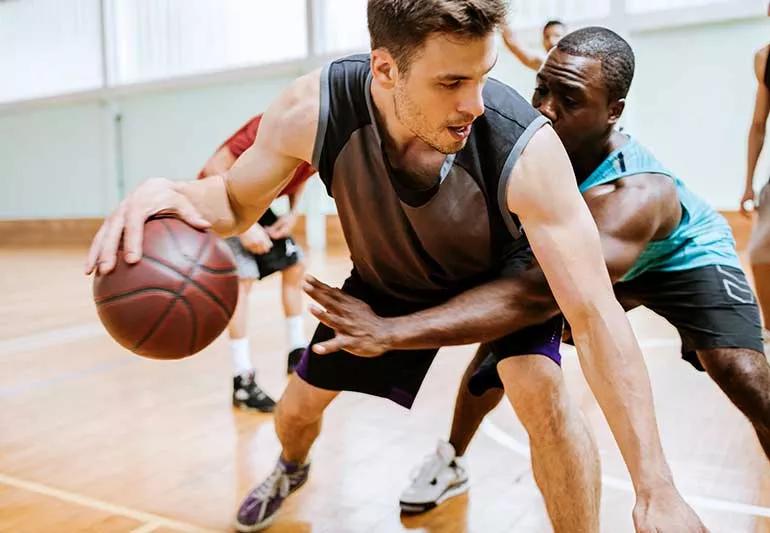Understand how your body creates energy to take your fitness to the next level

Metabolic conditioning can take your body from a sputtering engine to a well-oiled machine. But the key lies in understanding your metabolic pathways.
Advertisement
Cleveland Clinic is a non-profit academic medical center. Advertising on our site helps support our mission. We do not endorse non-Cleveland Clinic products or services. Policy
I’m sorry, your … huh?
“Your metabolic pathways are the three major ways your body produces energy,” says Ernest Miller, PT, DPT, CSCS, a physical therapist and certified strength and conditioning specialist. “How you target and train each can help optimize your health and fitness.”
Dr. Miller explains the ins and outs of your metabolic pathways and how to use each one to ramp up your physical fitness.
Like cars, humans need fuel to function. Instead of electricity or oil, food is our fuel. But a lot needs to happen to that piece of toast before your body can use it to power up.
Here’s how it works.
The cells of all living things have ATP (adenosine triphosphate) inside them. ATP is a molecule that brings energy to the parts of the cell where it’s needed. Digestion converts food into ATP. Then, very small amounts of ATP are stored — like money in a bank — in your body. They can be used as needed. But since only a small amount is stored, your body relies on its metabolic pathways to create the rest of the ATP it needs.
“Anything the body does — from breathing to competing in professional athletics — requires ATP,” Dr. Miller says. “The body uses different metabolic pathways, or types of chemical reactions, to produce the right kind of energy to fuel different activities.”
Advertisement
Yourbody has three different metabolic pathways:
Phosphocreatine (PC) is a molecule in your muscles that can make ATP in the blink of an eye. It’s also known as creatine phosphate (CP). And while PC is available when you need it, there isn’t a lot to go around.
“You store a small amount of PC that you can quickly access for bursts of high-intensity effort,” Dr. Miller explains.
Think of your phosphagen system as your immediate energy system. It’s the grab-and-go energy your body needs to jump out of the way of an oncoming train. In weightlifting, it’s what you use to achieve your one-rep max (the highest amount of weight you can lift for one repetition).
“High-intensity movements that last between five and 10 seconds use this immediate energy cycle. Your body doesn’t have time to go through the other two longer metabolic pathways,” Dr. Miller adds. “Because PC is stored in your muscles, it’s immediately available to use.”
To understand the glycolytic system, let’s break down the word’s roots.
“Anaerobic glycolysis breaks down sugar to fuel activity. Like PC, glycogen is stored in your muscles,” Dr. Miller says. “But glycogen takes longer to break down.”
After about six to 10 seconds of high-intensity effort, your phosphagen system’s PC has run dry. So, for intense activities and exercise that last longer — from one to three minutes — your glycolytic system takes the lead. Think of the glycolytic system as your short-term energy system.
Any activity that requires endurance uses the oxidative pathway.
“Your body uses the oxidative pathway for anything that lasts longer than several minutes. After three to five minutes of intense energy use, it’ll kick in,” Dr. Miller says.
With the oxidative (or aerobic) system, your body needs oxygen to make ATP.
“The phosphagen and glycolytic systems are anaerobic, meaning they produce energy without using oxygen,” Dr. Miller explains. “Without the need for oxygen, they can kick into gear faster than the aerobic system.”
The oxidative system fuels activities such as 30 minutes on an elliptical machine or running a 5K or even a marathon.
“A marathon runner runs at a lower intensity than a 100-meter sprinter does. While sprinters need a lot of energy quickly, they run out of it just as fast,” Dr. Miller adds. “But endurance athletes can reach a steady state where they run at the same speed for miles. Their aerobic system isn’t as fast. But because the exercise is less intense, they’re able to make energy at the same rate they use it — and last longer.”
Advertisement
Now, it’s possible — and beneficial— to train your body to use each metabolic system, a process called metabolic conditioning.
“Depending on your goals, there are reasons to condition your body to use one metabolic pathway more than others,” Dr. Miller says.
For example, playing American football involves short, intense periods of activity with rest in between each play. That’s why American football players benefit when they place an emphasis on conditioning their phosphagen (remember, immediate) system.
“Compare that to soccer players,” Dr. Miller says. “Soccer is continuous. It’s a 90-minute game. The athletes are always running with very few stops. Soccer relies more on your glycolytic and oxidative systems. Different sports require better utilization of different metabolic pathways.”
The three metabolic pathways are like the three musketeers — when you train one, you’re training them all.
“There’s a misconception that you can switch between each system, but actually they’re all working simultaneously,” Dr. Miller says. “The difference lies in what percentage of each system you’re using at a given time.”
Dr. Miller emphasizes that a well-rounded fitness program will condition all three. But prioritizing any one specific pathway over another can help you reach certain activity and fitness goals.
Advertisement
“If you want to run a 5K or perform other endurance activities, your metabolic conditioning should be geared more toward using your oxidative (long-term) system. Whereas somebody who wants to make gains lifting weights might want to start conditioning the phosphagen (immediate) system,” Dr. Miller says.
Not sure where to start? Choose activities and exercises that tap into the metabolic system you’re targeting. Pay particular attention to your intensity level and how long you’re working and resting.
The keys to working this system are:
Hint: If you can sustain your intensity for longer, it’s not your max, and you’re working the wrong system.
Examples of activities that work your phosphagen system include:
For this system, you want to feel like you are pushing yourself but you can still maintain a moderate intensity workout for two to three minutes at a time. Aim for a brief rest in between.
Activities that train your glycolytic system include:
Advertisement
Training your oxidative system
Aerobic system training should last much longer than training the other systems.
“You should take shorter breaks because the intensity is low enough to do repeated bouts,” Dr. Miller explains.
Aim for a few hours each week. You can break that down by doing about 20 to 30 minutes of exercise, three to five times per week. Examples of aerobic activities include:
“If you’re just getting started with exercise, start with a slow- to brisk-paced walk. Build up to 20 to 30 minutes at a time,” Dr. Miller recommends. “As your cardiovascular fitness builds, walk faster. Then move on to alternate periods of walking and jogging. From there, you can progress to jogging for 20 to 30 minutes at a time.”
If riding a stationary bike is your thing, Dr. Miller says cycling carries the added bonus of training all three metabolic systems.
Before you try metabolic conditioning, Dr. Miller recommends checking in with your healthcare provider.
“An annual physical can screen you for cardiovascular and lung conditions that would prevent you from safely starting a new exercise program,” Dr. Miller advises.
If everything looks good, the next step would be consulting a fitness professional. Qualified fitness professionals include athletic trainers, exercise physiologists, personal trainers, strength coaches and physical therapists.
“They can help guide you because it’s important to tailor metabolic conditioning to your abilities and your goals,” Dr. Miller says. “They can help you sift through all the noise, see where you’re at, what your goals are and help you find an appropriate place to start.”
Learn more about our editorial process.
Advertisement

It depends on factors like your age, activity level and if you want to maintain, lose or gain weight

Avocados, cheese and nuts are high in calories but have big health benefits

Calorie counts on nutrition labels can be off by up to 20%

Focus on your body’s metabolic set point by eating healthy foods, making exercise a part of your routine and reducing stress

Calorie reduction can do more than just help you lose weight — it can also lower age-related inflammation

Your metabolism may torch 1,300 to 2,000 calories daily with no activity

Consuming fewer calories than your body burns is a ‘calorie deficit’ that can lead to weight loss

When free radicals don’t have antioxidants to keep them in check, they go rogue

Start having sex about 72 hours before ovulation, then at least every other day during your fertile window

Attachment theory suggests that your earliest relationships shape connections throughout your life

It isn’t a recognized mental health disorder, but research shows that problematic social media use can negatively affect your mental health, self-esteem and sleep